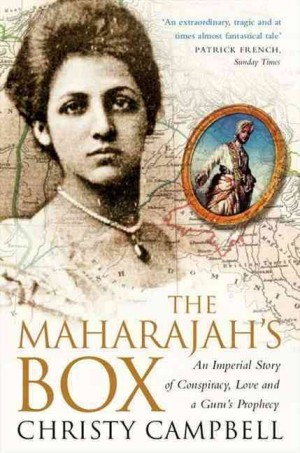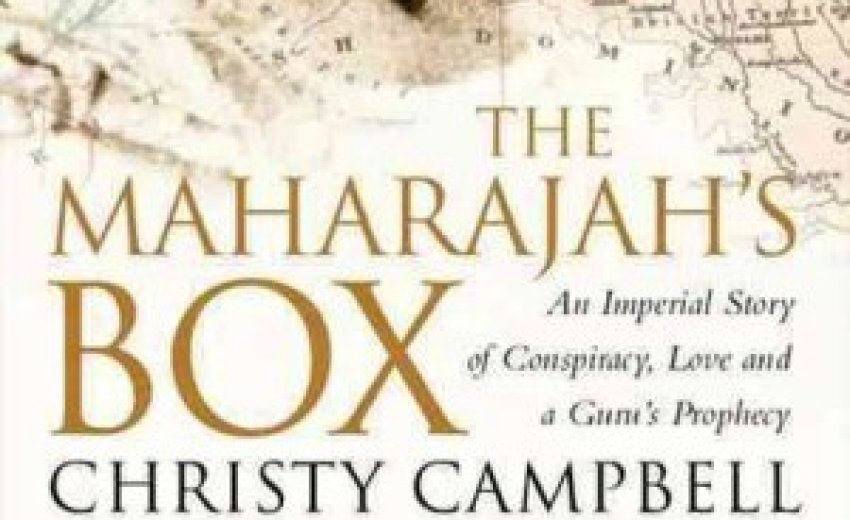Book Review
The Maharajah's Box: An Imperial Story of Conspiracy, Love and a Guru's Prophecy
 |
 |
A Review by Hardev Singh Virk
The Maharajah's Box is a most fascinating account of the life story of the exiled King of Punjab, Maharajah Duleep Singh. Christy Campbell, the author, is a journalist, writer and former defense correspondent for the Sunday Telegraph. He has not spared any effort to dig up the resource material and meticulously researched the historical documents concerning the Sikh Kingdom of Punjab. Maharaja's Box is a tale of murder, deception and riches beyond imagination and it reads like a historical novel.
On the death of Ranjit Singh in 1839, the Sikh Kingdom of Lahore was the most powerful in India but it was annexed by the British Indian Government in 1849. Maharaja Duleep Singh, the last King of the Punjab, was born on 6 September 1838, occupied the throne at the age of 5 and removed from the throne in 1849. The deposed Maharajah was placed under the guardianship of Sir John Login and brought to England. He was baptised as a Christian before his deportation. Rani Jindan, his mother, was imprisoned in Fort Chunar from where she escaped to Nepal. Duleep Singh was liberally treated and provided an annual pension of 50,000 pounds in England. He purchased a large estate of 16,000 acres at Elveden in Suffolk and settled down as a country gentleman.
The title of the book has nothing to do with the contents. It all started with the declaration of an unclaimed Swiss bank account in the name of Princess Catherine Hilda Duleep Singh that the author began his investigations and penned down the true tragedy of the last King of Lahore, Maharajah Duleep Singh. He visited Punjab and Delhi to search for Maharajah's descendants. It was believed that the box in Swiss bank may contain jewellery and other valuable documents about the Sikh Empire but nothing of that sort happened.
In chapter 4 "The Lion", the author highlights the glory of Sikh Darbar at Lahore as depicted in a painting by Theodor Schoefft, a Hungarian. The Sikh Empire had grown into an independent state of conspicuous wealth and power. Its army, tutored by Prussian , French, American and Spanish generals, had become the most formidable fighting machine outside British India. After Ranjit Singh's death, the British wanted an excuse for takeover and the Sikhs themselves provided it. Lord Ellenborough, the Governor-General of India predicted, "The break-up of the Punjab will probably begin with murder". How true his prediction proved to be. The Sikh Empire disintegrated within a decade after the death of "Lion of Punjab". The author narrates the stories of death and mayhem carried out by courtiers and the Khalsa army of Ranjit Singh leading to chaos in Punjab.
Lord Dalhousie put young Maharajah Duleep Singh under the charge of Dr. and Mrs. Login. He was baptised on 8 March 1853 and his long Sikhly hair were cut off as a part of denaturing process. He was deported to England on the steamer SS Hindustan on 19 April 1854, reaching London in end of May. He was introduced to the Royal family at Windsor Palace and the Queen Victoria felt infatuated with his youth and beauty. The Maharajah had come to Windsor on several occasions and the Queen got his portraits made by the celebrated court painter of Frankfurt, Franz Winterhalter in 1855. He made friendship with Prince of Wales and enjoyed the company of princesses. It was during one such Winterhalter sitting that the Queen persuaded the Maharajah to gift her the Kohi-Noor diamond, the mountain of light. The Queen showered her affection, generosity and sympathy for the young Maharajah which was not liked by Lord Dalhousie. Duleep Singh was not allowed public school or University education but Prince Albert appointed tutors to teach him science, music and German and he became well versed in all. In 1863, he left London and settled down at Elveden estate in Suffolk.
Return to Sikh Faith and Guru's Prophecy:
The poignant and pathetic tale of Rani Jindan, the mother of Duleep Singh, is touched briefly by the author. Christy Campbel has been rather unkind to the role of Jindan in the whole episode. Mother and son met in Calcutta on 16 January 1861 after thirteen and half years. She was shocked to discover Duleep as a clean-shaven young man and told him bluntly that she did not repent the loss of Sikh Kingdom so much as the loss of his Sikh faith. Duleep took Jindan to England where she died in 1863. She was cremated according to the Sikh rites in India and her ashes scattered in the waters of the Godavri river at Nasik. as Maharajah was banned to visit Punjab. On his return journey, Maharajah stopped in Cairo and married a pretty girl, Bamba Muller. His marriage was solemnized as per Christian rites.
Rani Jindan told Duleep about Guru's prophecy that he shall rule over India but he did not believe. In 1883, Thakur Singh Sandhanwalia, cousin to Duleep Singh, was summoned to England. It was Thakur Singh who convinced the Maharajah about the truth of Guru's prophecy and prevailed upon him to return to the Sikh faith. This prophecy was broadcast mainly by the Kukas in Punjab who were fighting against the British Empire in India. A part of the prophecy ran: "When the Russian troops invade the country, agitation will prevail in London and the British army will march to India. A Sikh martyr will be born and will reign as far as Calcutta. Duleep Singh will shine among the Khalsa and will drive his elephant throughout the world".
Convinced of Guru's prophecy, Duleep Singh wrote an impassioned appeal on 25 March 1886 in name of his countrymen : "I beg forgiveness of you, Khalsa-Ji, for having forsaken the faith of my ancestors for a foreign religion. It is my fond desire to take the Pahul again on reaching Bombay". Maharajah was disuaded not to visit India but he had resolved to do so. He set sail with his family but was detained at Aden on 21 April 1886. After a few days, his family returned to England. Maharajah Duleep Singh was administered Khande Di Pahul on 25 May 1886 at Aden but not allowed to visit India. Heart-broken and frustrated, Maharajah returned to Paris in July 1886. In Paris, he set up his headquarters to start his revolutionary activities against the British Empire. But he was not a gifted conspirator according to the author of the book.
Paris was a meeting point for revolutionaries. Duleep Singh met Irish rebels and Russian diplomats in Paris. He issued two proclamations from Paris, the first to the Sikh brethren and the second was addressed to 'Brother Princes and Nobles and the people of beloved Hindustan', declaring himself as the Maharajah of Sikhs and exhorting them to revolt against the British Empire.
Journey to Russia:
Maharajah Duleep Singh travelled to St. Petersburg, the Russian capital, under the false identity as Mr. Patrick Casey, the Irish rebel. He was accompanied by a young pretty girl, Ada Wetherill, whom he married in Paris after his return from Russia. Mikhail Katkov, the editor of the Moscow Gazette and a staunch nationalist, invited Maharajah. Katkov and his collaborators in Paris campaigned for a Franco-Russian alliance and had strong influence on the Russian Czar, Alexander III. Unfortunately, Katkov fell from Czar's grace, died of cancer in Moscow and Duleep Singh failed in his mission. He wandered for a year in Russia as a frustrated man.
Duleep Singh wrote a detailed letter to Russian Czar on 10 May 1887, asking for his help in liberation of India. He also mentioned his Guru's prophecy in this letter. It was a masterly plan in tactics and geo-political warfare. Czar made comments on its contents but did not adhere to Maharajah's plan of action. Maharajah dispatched his emissary, Arur Singh, to India with letters of revolt addressed to Indian princes. After the death of his sponsorer, Mr. Katkov, in August 1887, all the schemes of Maharajah to liberate India with the help of Russian army came to naught.
The British has penetrated the Maharaja's conspiracy with impeccable accuracy. All his letters were copied and dispatched to the office of Secretary of State for India in London by the French officer-in charge of Maharajah in Paris. Arur Singh was captured in Calcutta and all the plans of Maharajah were revealed by him during his interrogation . Thakur Singh Sandhanwalia acted as Maharajah's Prime Minister-in-exile. He was based in Pondicherry, the French colony in India. He died (some believe poisoned) while Maharajah was still negogiating his terms with the Russian Czar. His family Jagir was confiscated by the British. The aspirations of the Khalsa in Punjab were aroused by the proclamations of Duleep Singh but nothing concrete was achieved except all round frustration.
Maharajah Duleep Singh returned to Paris and married Ada Douglas Wetherill, who also acted as a British spy during his sojourn in Russia. The network of British spies was so perfect that all his movements were reported to London and Simla simultaneously. He had eight children, six from his first wife and two girls from the second. All of them died issueless, as a consequence of another prophecy of the Guru! Maharajah Duleep Singh, the last King of the Punjab, died in a Paris hotel on 21 October, 1893. He was buried in Elveden Estate cemetery, not as a Sikh but a Christian. The Maharajah's Box by Christy Campbell is a heart-rending account of the life of the last Sikh Maharajah of Punjab.
Hardev Singh Virk
http://drhsvirk.weebly.com






